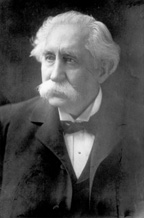 | |||
| General William Bate, 25th Governor of Tennessee |
HEADQUARTERS
Brooke’s Station, June 28, 1861.
Hon. L. P. WALKER, Secretary of War:
SIR: Pursuant to your instructions, received last night, I dispatched Colonel Bate, with the effective force of his regiment present, to support Commander Lewis, C. S. Navy. I consider the command (about four hundred) unnecessarily strong, as Colonel Bate is positively ordered to take no part in the expedition on the water. I sincerely hope your excellency will not consider me extra cautious in this matter, for when we consider that an indispensable requisite to success would be the absolute concealment of three hundred or four hundred men on a comparatively small steamer, and those men untrained volunteers, and that this is only one of several other contingencies equally difficult to be reconciled, it seems to me the success would be miraculous.
I am, sir, very respectfully, your obedient servant,
TH. H. HOLMES,
Brigadier-General, Commanding
The expedition referenced is one of the most bizarre incidents of the war. Lewis had observed the side wheeler St. Nicholas regularly approach the warship U.S.S. Pawnee without challenge and hatched a plan to capture the St. Nicholas, embark several hundred men of Bate’s 2nd Tennessee Infantry, and then approach the Pawnee as usual, and then board and capture her. Confederate Navy Captain George N. Hollins and Maryland Colonel Richard Thomas (a small man dressed and representing himself as a French woman) boarded the St. Nicholas on its regular Baltimore to Georgetown run along with 25 of Thomas’ fifty man unit of Zuoaves who boarded as passengers. They succeeded in capturing the St. Nicholas and ran it into the Coan River near the mouth of the Potomac where they embarked (contrary to orders) part of Bate’s command who had been sent to provide infantry support for the landing. The St. Nicholas put back out in search of the Pawnee but was unable to locate it, capturing along the way two commercial schooners and a brig. They returned by way of the Rappanhanock to Fredericksburg. In July Thomas returned to Baltimore and tried the same trick again, only to be recognized, arrested, and held in prison until being exchanged in 1863. Thomas also used the name Zarvona, after a French women he had fallen in love with who had passed away during a foreign adventure of Thomas’ before the war. Bate went on to become a Major General in the Army of the Tennessee.
Official Records, Series I., Vol. 2, Page 959.
No comments:
Post a Comment